Managerial Economics Report: Market Structures and Government Policies
VerifiedAdded on 2023/04/21
|27
|4358
|268
Report
AI Summary
This report delves into key microeconomic concepts relevant to managerial economics. Section A examines the interplay of demand and supply, market equilibrium, characteristics of perfectly competitive markets, the marginal productivity theory for determining equilibrium employment, price elasticity of demand, and government interventions to address market failures. Section B shifts focus to supply-side aspects, analyzing changes in business strategies influenced by shifts in market structures and regulatory policies. The report covers various scenarios, including changes in journalist salaries, major news events, team performance impacts on product demand, input cost fluctuations, consumer behavior changes, and textbook market dynamics, providing a comprehensive overview of market adjustments and strategic considerations. The analysis includes the application of elasticity formulas and discussions of government policies like taxation to correct market inefficiencies. The report provides a thorough analysis of market forces and strategic decision-making in a business context.
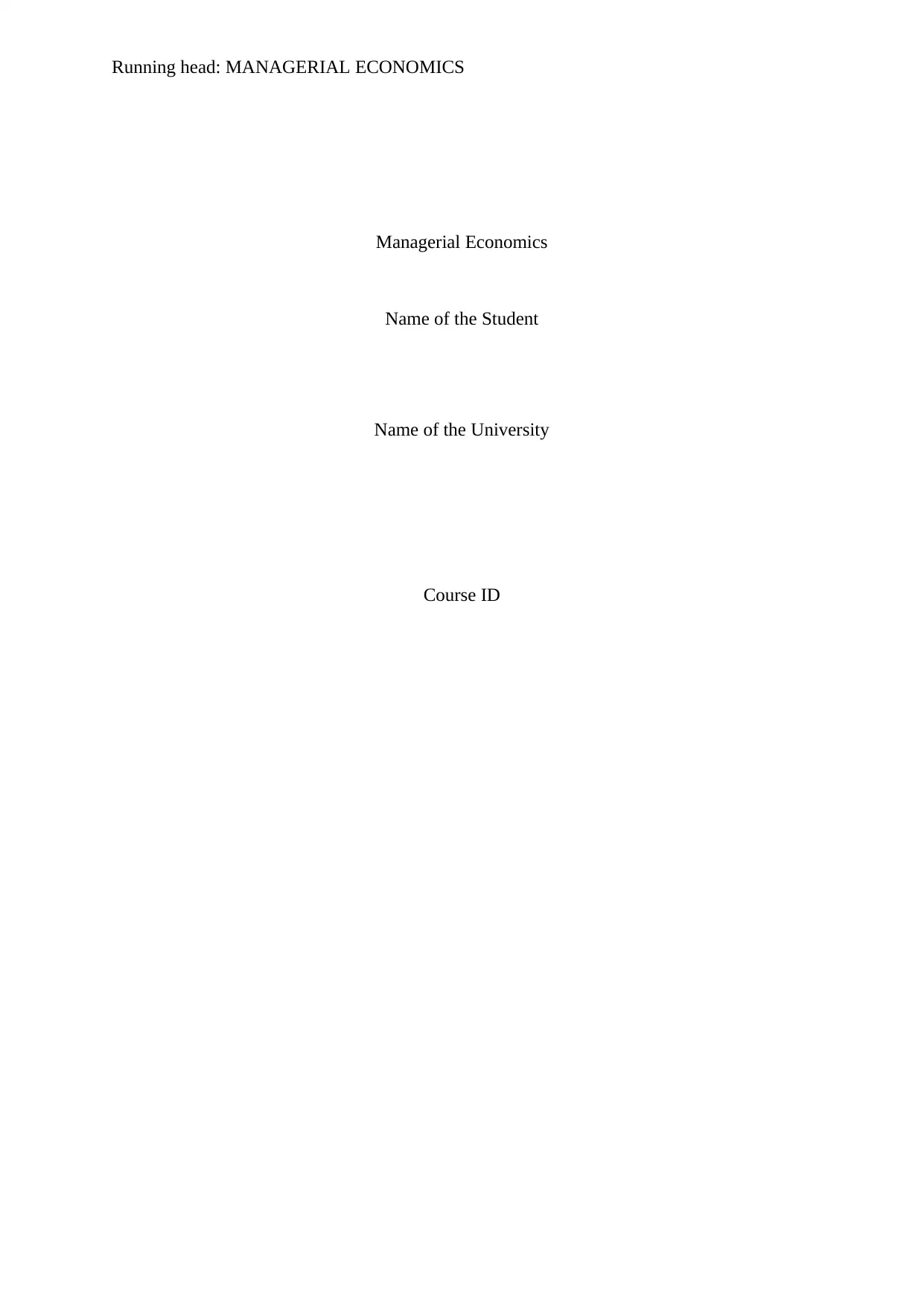
Running head: MANAGERIAL ECONOMICS
Managerial Economics
Name of the Student
Name of the University
Course ID
Managerial Economics
Name of the Student
Name of the University
Course ID
Paraphrase This Document
Need a fresh take? Get an instant paraphrase of this document with our AI Paraphraser
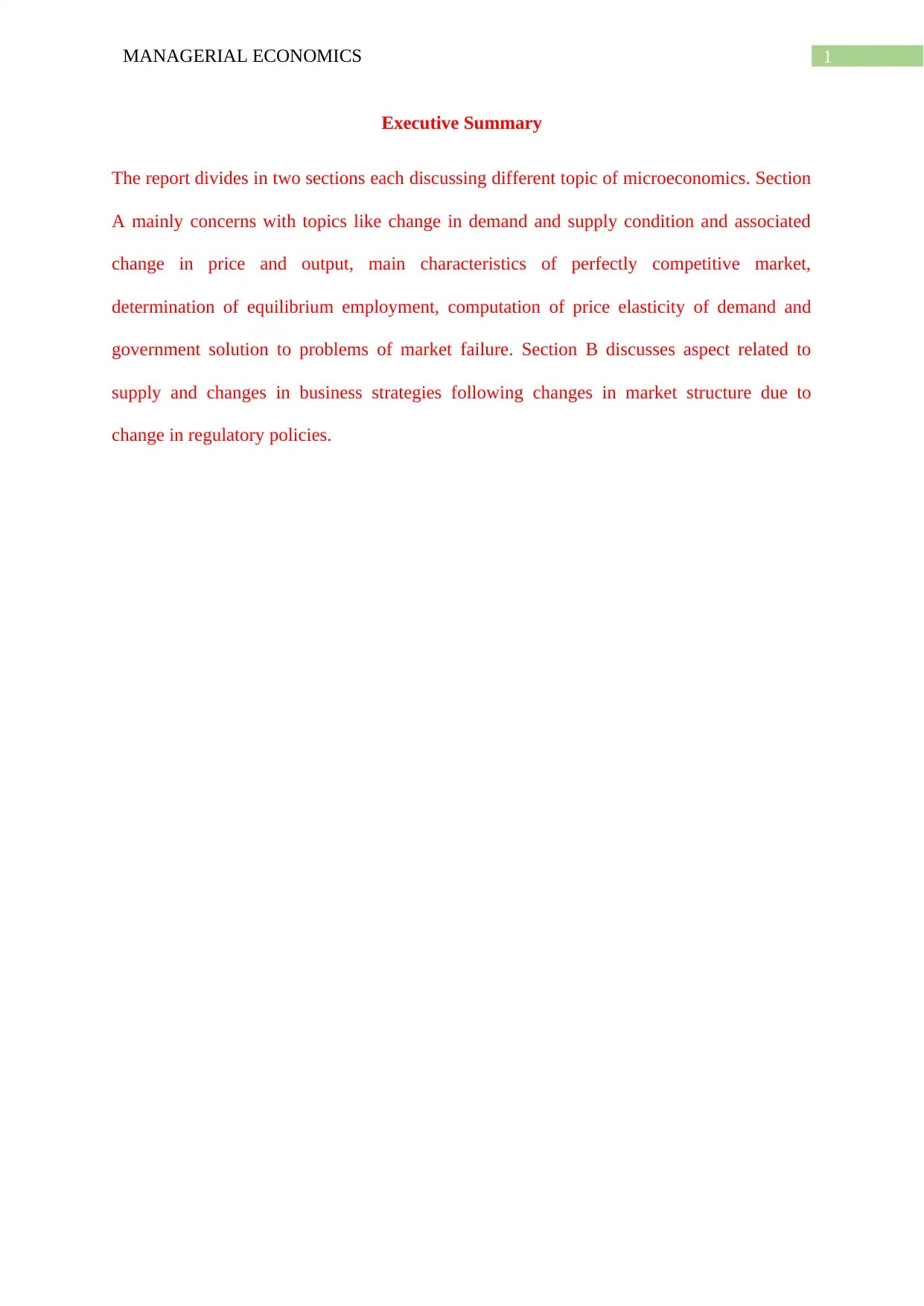
1MANAGERIAL ECONOMICS
Executive Summary
The report divides in two sections each discussing different topic of microeconomics. Section
A mainly concerns with topics like change in demand and supply condition and associated
change in price and output, main characteristics of perfectly competitive market,
determination of equilibrium employment, computation of price elasticity of demand and
government solution to problems of market failure. Section B discusses aspect related to
supply and changes in business strategies following changes in market structure due to
change in regulatory policies.
Executive Summary
The report divides in two sections each discussing different topic of microeconomics. Section
A mainly concerns with topics like change in demand and supply condition and associated
change in price and output, main characteristics of perfectly competitive market,
determination of equilibrium employment, computation of price elasticity of demand and
government solution to problems of market failure. Section B discusses aspect related to
supply and changes in business strategies following changes in market structure due to
change in regulatory policies.
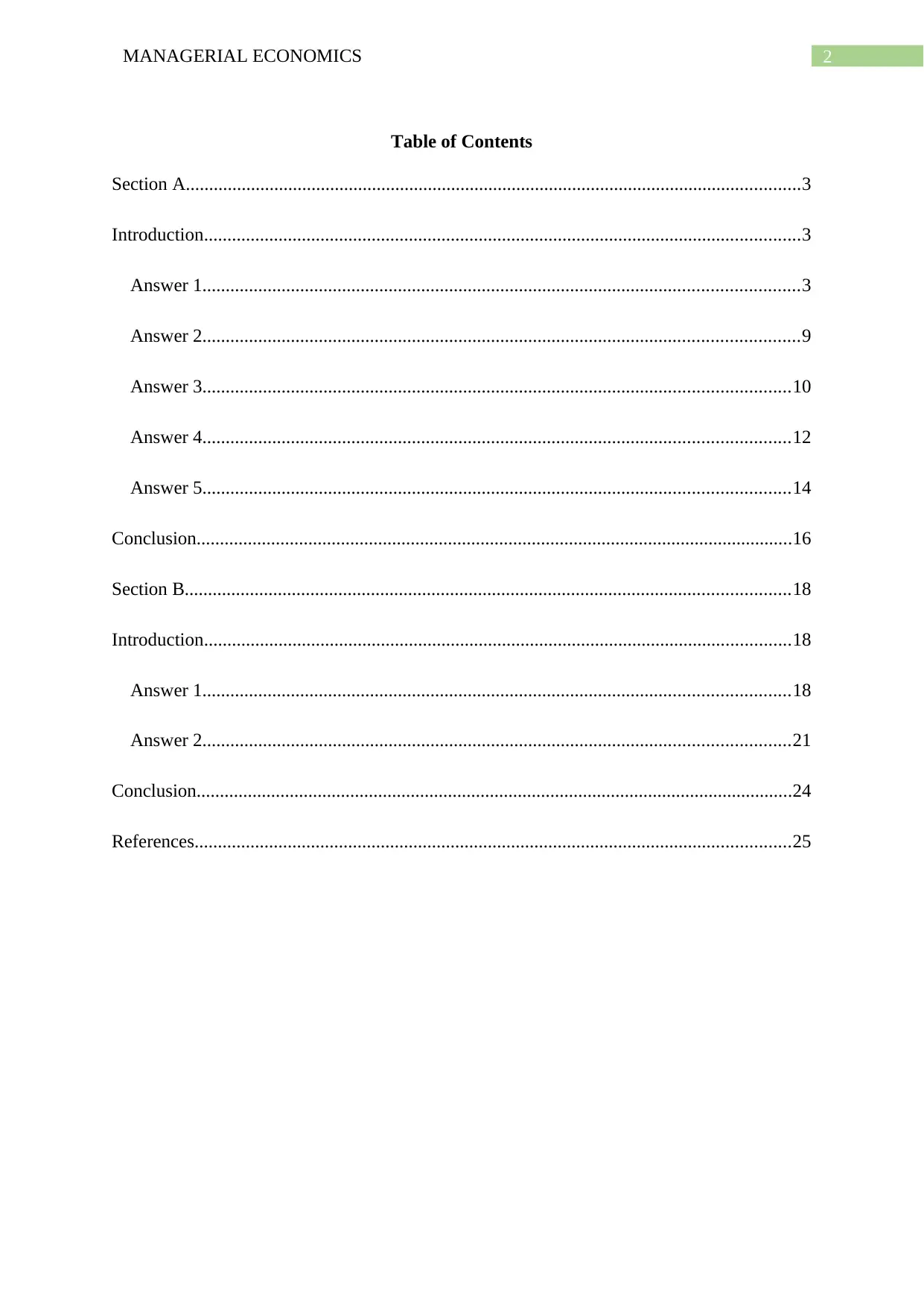
2MANAGERIAL ECONOMICS
Table of Contents
Section A....................................................................................................................................3
Introduction................................................................................................................................3
Answer 1................................................................................................................................3
Answer 2................................................................................................................................9
Answer 3..............................................................................................................................10
Answer 4..............................................................................................................................12
Answer 5..............................................................................................................................14
Conclusion................................................................................................................................16
Section B..................................................................................................................................18
Introduction..............................................................................................................................18
Answer 1..............................................................................................................................18
Answer 2..............................................................................................................................21
Conclusion................................................................................................................................24
References................................................................................................................................25
Table of Contents
Section A....................................................................................................................................3
Introduction................................................................................................................................3
Answer 1................................................................................................................................3
Answer 2................................................................................................................................9
Answer 3..............................................................................................................................10
Answer 4..............................................................................................................................12
Answer 5..............................................................................................................................14
Conclusion................................................................................................................................16
Section B..................................................................................................................................18
Introduction..............................................................................................................................18
Answer 1..............................................................................................................................18
Answer 2..............................................................................................................................21
Conclusion................................................................................................................................24
References................................................................................................................................25
⊘ This is a preview!⊘
Do you want full access?
Subscribe today to unlock all pages.

Trusted by 1+ million students worldwide
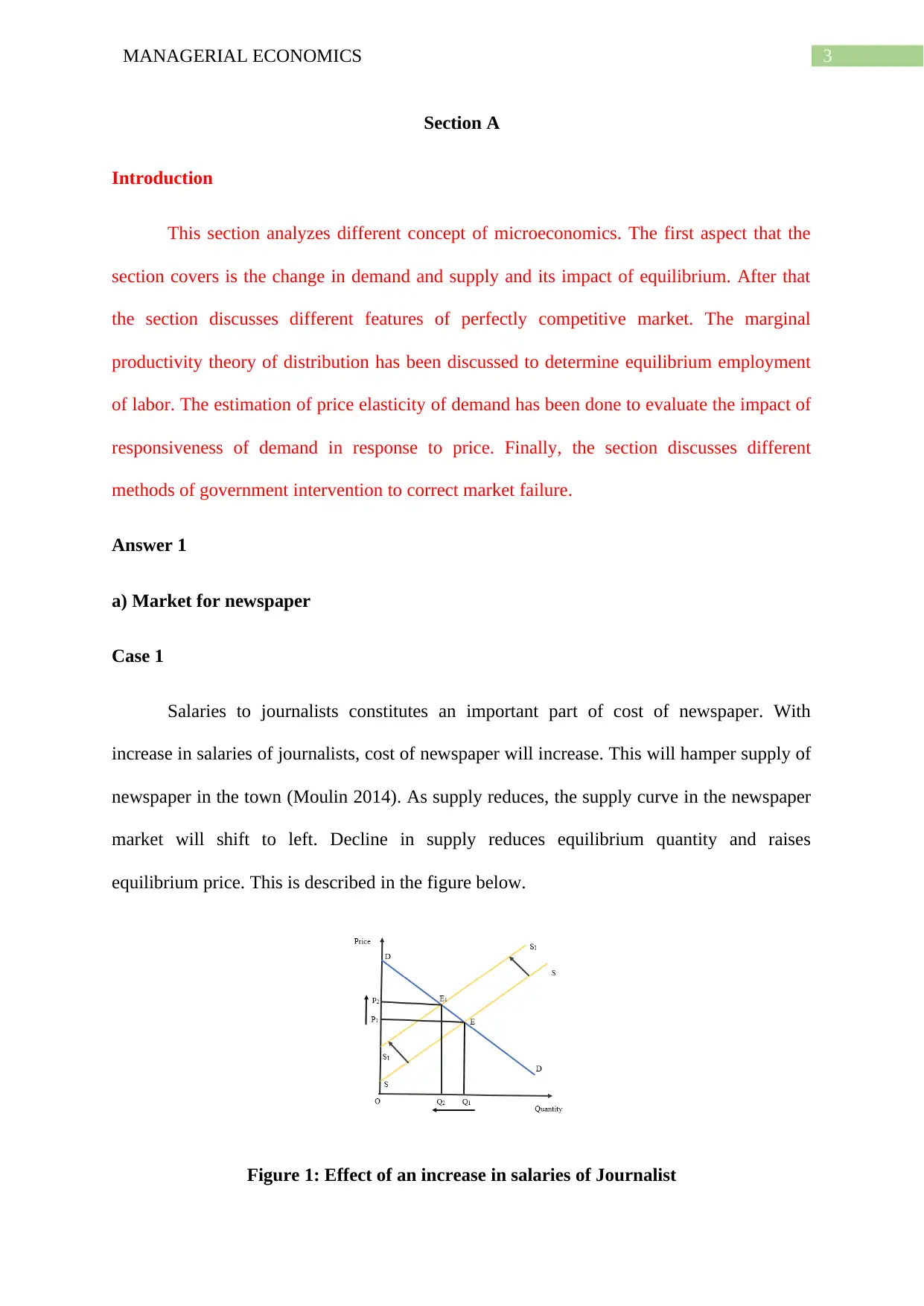
3MANAGERIAL ECONOMICS
Section A
Introduction
This section analyzes different concept of microeconomics. The first aspect that the
section covers is the change in demand and supply and its impact of equilibrium. After that
the section discusses different features of perfectly competitive market. The marginal
productivity theory of distribution has been discussed to determine equilibrium employment
of labor. The estimation of price elasticity of demand has been done to evaluate the impact of
responsiveness of demand in response to price. Finally, the section discusses different
methods of government intervention to correct market failure.
Answer 1
a) Market for newspaper
Case 1
Salaries to journalists constitutes an important part of cost of newspaper. With
increase in salaries of journalists, cost of newspaper will increase. This will hamper supply of
newspaper in the town (Moulin 2014). As supply reduces, the supply curve in the newspaper
market will shift to left. Decline in supply reduces equilibrium quantity and raises
equilibrium price. This is described in the figure below.
Figure 1: Effect of an increase in salaries of Journalist
Section A
Introduction
This section analyzes different concept of microeconomics. The first aspect that the
section covers is the change in demand and supply and its impact of equilibrium. After that
the section discusses different features of perfectly competitive market. The marginal
productivity theory of distribution has been discussed to determine equilibrium employment
of labor. The estimation of price elasticity of demand has been done to evaluate the impact of
responsiveness of demand in response to price. Finally, the section discusses different
methods of government intervention to correct market failure.
Answer 1
a) Market for newspaper
Case 1
Salaries to journalists constitutes an important part of cost of newspaper. With
increase in salaries of journalists, cost of newspaper will increase. This will hamper supply of
newspaper in the town (Moulin 2014). As supply reduces, the supply curve in the newspaper
market will shift to left. Decline in supply reduces equilibrium quantity and raises
equilibrium price. This is described in the figure below.
Figure 1: Effect of an increase in salaries of Journalist
Paraphrase This Document
Need a fresh take? Get an instant paraphrase of this document with our AI Paraphraser
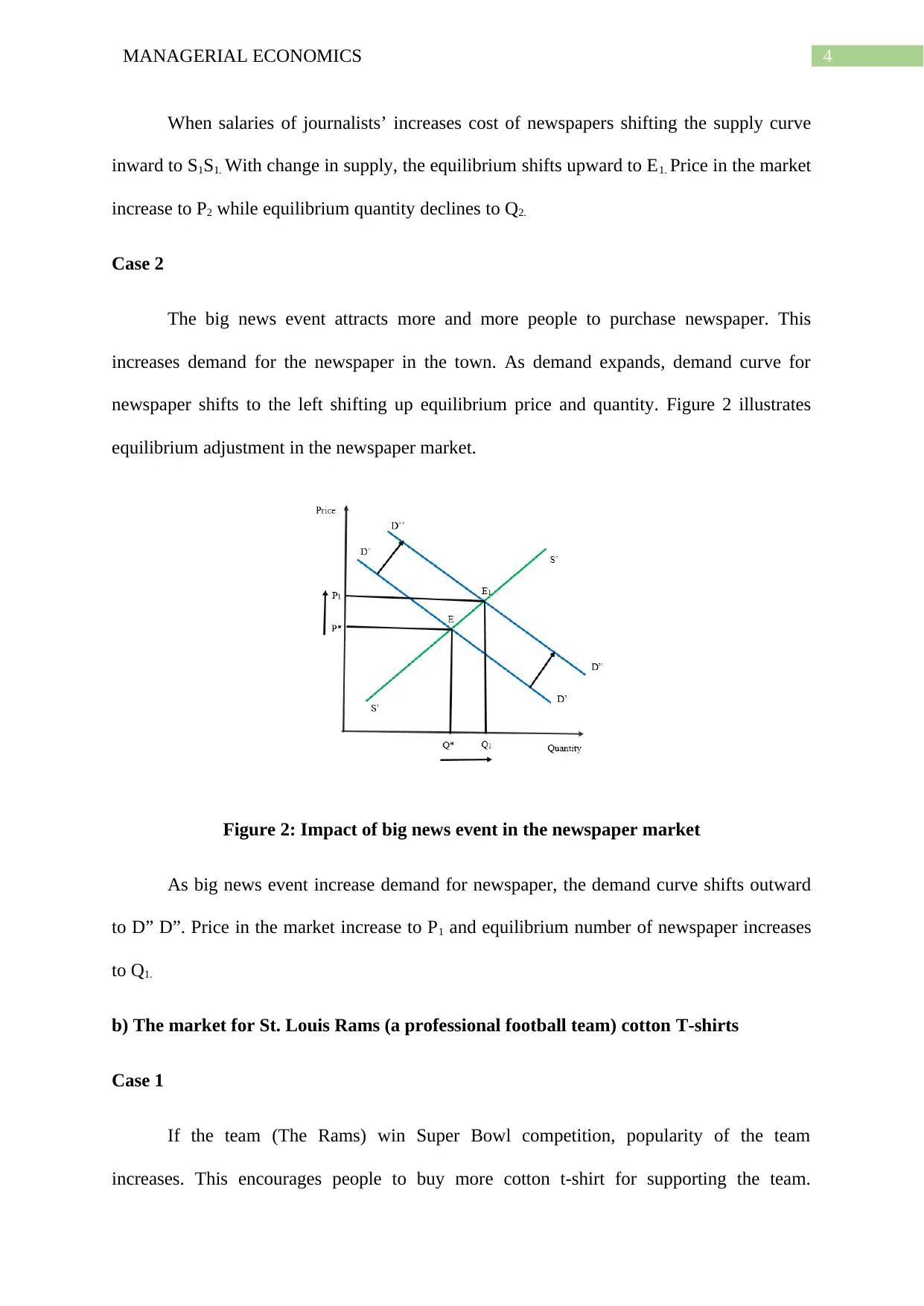
4MANAGERIAL ECONOMICS
When salaries of journalists’ increases cost of newspapers shifting the supply curve
inward to S1S1. With change in supply, the equilibrium shifts upward to E1. Price in the market
increase to P2 while equilibrium quantity declines to Q2.
Case 2
The big news event attracts more and more people to purchase newspaper. This
increases demand for the newspaper in the town. As demand expands, demand curve for
newspaper shifts to the left shifting up equilibrium price and quantity. Figure 2 illustrates
equilibrium adjustment in the newspaper market.
Figure 2: Impact of big news event in the newspaper market
As big news event increase demand for newspaper, the demand curve shifts outward
to D” D”. Price in the market increase to P1 and equilibrium number of newspaper increases
to Q1.
b) The market for St. Louis Rams (a professional football team) cotton T-shirts
Case 1
If the team (The Rams) win Super Bowl competition, popularity of the team
increases. This encourages people to buy more cotton t-shirt for supporting the team.
When salaries of journalists’ increases cost of newspapers shifting the supply curve
inward to S1S1. With change in supply, the equilibrium shifts upward to E1. Price in the market
increase to P2 while equilibrium quantity declines to Q2.
Case 2
The big news event attracts more and more people to purchase newspaper. This
increases demand for the newspaper in the town. As demand expands, demand curve for
newspaper shifts to the left shifting up equilibrium price and quantity. Figure 2 illustrates
equilibrium adjustment in the newspaper market.
Figure 2: Impact of big news event in the newspaper market
As big news event increase demand for newspaper, the demand curve shifts outward
to D” D”. Price in the market increase to P1 and equilibrium number of newspaper increases
to Q1.
b) The market for St. Louis Rams (a professional football team) cotton T-shirts
Case 1
If the team (The Rams) win Super Bowl competition, popularity of the team
increases. This encourages people to buy more cotton t-shirt for supporting the team.
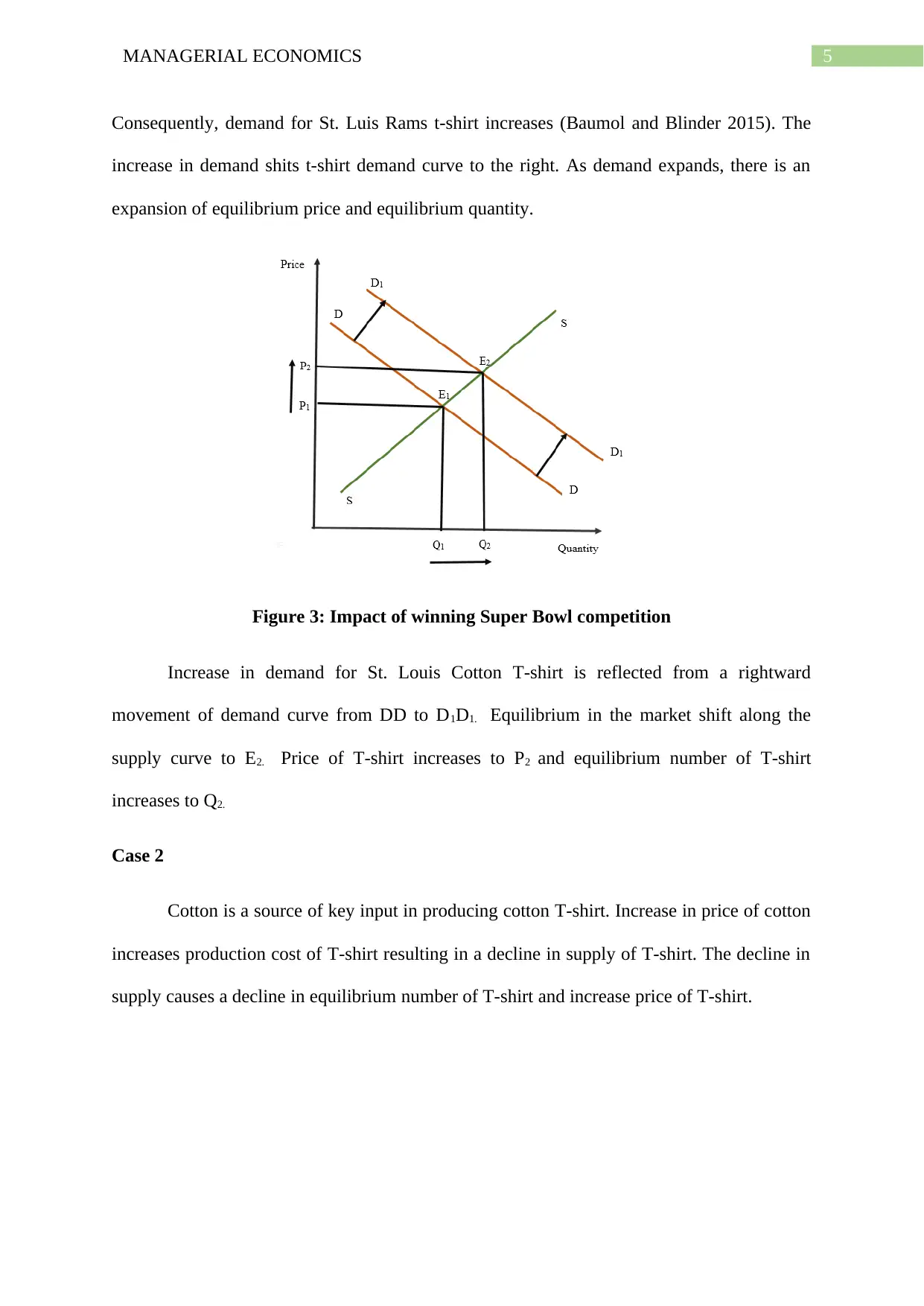
5MANAGERIAL ECONOMICS
Consequently, demand for St. Luis Rams t-shirt increases (Baumol and Blinder 2015). The
increase in demand shits t-shirt demand curve to the right. As demand expands, there is an
expansion of equilibrium price and equilibrium quantity.
Figure 3: Impact of winning Super Bowl competition
Increase in demand for St. Louis Cotton T-shirt is reflected from a rightward
movement of demand curve from DD to D1D1. Equilibrium in the market shift along the
supply curve to E2. Price of T-shirt increases to P2 and equilibrium number of T-shirt
increases to Q2.
Case 2
Cotton is a source of key input in producing cotton T-shirt. Increase in price of cotton
increases production cost of T-shirt resulting in a decline in supply of T-shirt. The decline in
supply causes a decline in equilibrium number of T-shirt and increase price of T-shirt.
Consequently, demand for St. Luis Rams t-shirt increases (Baumol and Blinder 2015). The
increase in demand shits t-shirt demand curve to the right. As demand expands, there is an
expansion of equilibrium price and equilibrium quantity.
Figure 3: Impact of winning Super Bowl competition
Increase in demand for St. Louis Cotton T-shirt is reflected from a rightward
movement of demand curve from DD to D1D1. Equilibrium in the market shift along the
supply curve to E2. Price of T-shirt increases to P2 and equilibrium number of T-shirt
increases to Q2.
Case 2
Cotton is a source of key input in producing cotton T-shirt. Increase in price of cotton
increases production cost of T-shirt resulting in a decline in supply of T-shirt. The decline in
supply causes a decline in equilibrium number of T-shirt and increase price of T-shirt.
⊘ This is a preview!⊘
Do you want full access?
Subscribe today to unlock all pages.

Trusted by 1+ million students worldwide
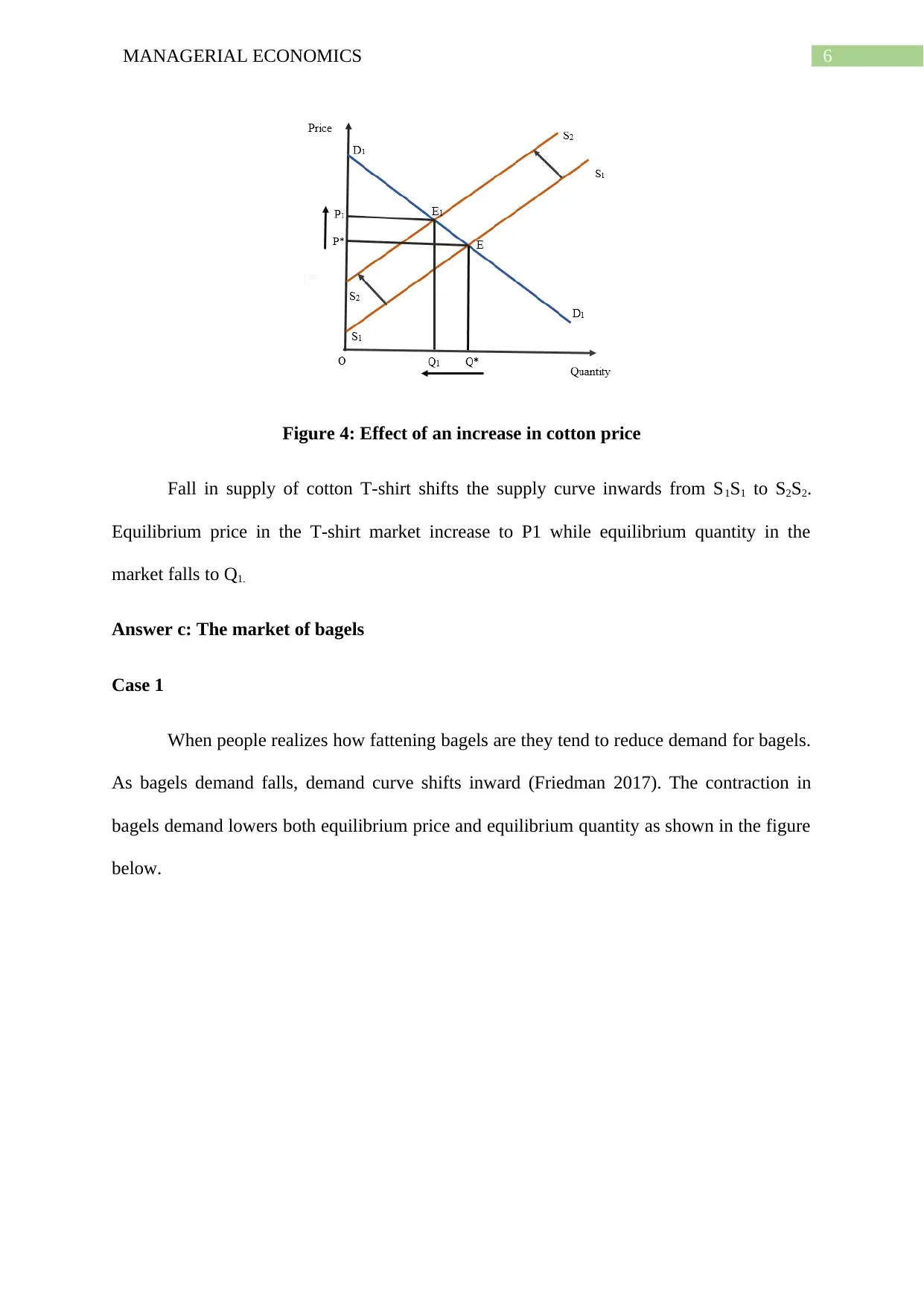
6MANAGERIAL ECONOMICS
Figure 4: Effect of an increase in cotton price
Fall in supply of cotton T-shirt shifts the supply curve inwards from S1S1 to S2S2.
Equilibrium price in the T-shirt market increase to P1 while equilibrium quantity in the
market falls to Q1.
Answer c: The market of bagels
Case 1
When people realizes how fattening bagels are they tend to reduce demand for bagels.
As bagels demand falls, demand curve shifts inward (Friedman 2017). The contraction in
bagels demand lowers both equilibrium price and equilibrium quantity as shown in the figure
below.
Figure 4: Effect of an increase in cotton price
Fall in supply of cotton T-shirt shifts the supply curve inwards from S1S1 to S2S2.
Equilibrium price in the T-shirt market increase to P1 while equilibrium quantity in the
market falls to Q1.
Answer c: The market of bagels
Case 1
When people realizes how fattening bagels are they tend to reduce demand for bagels.
As bagels demand falls, demand curve shifts inward (Friedman 2017). The contraction in
bagels demand lowers both equilibrium price and equilibrium quantity as shown in the figure
below.
Paraphrase This Document
Need a fresh take? Get an instant paraphrase of this document with our AI Paraphraser
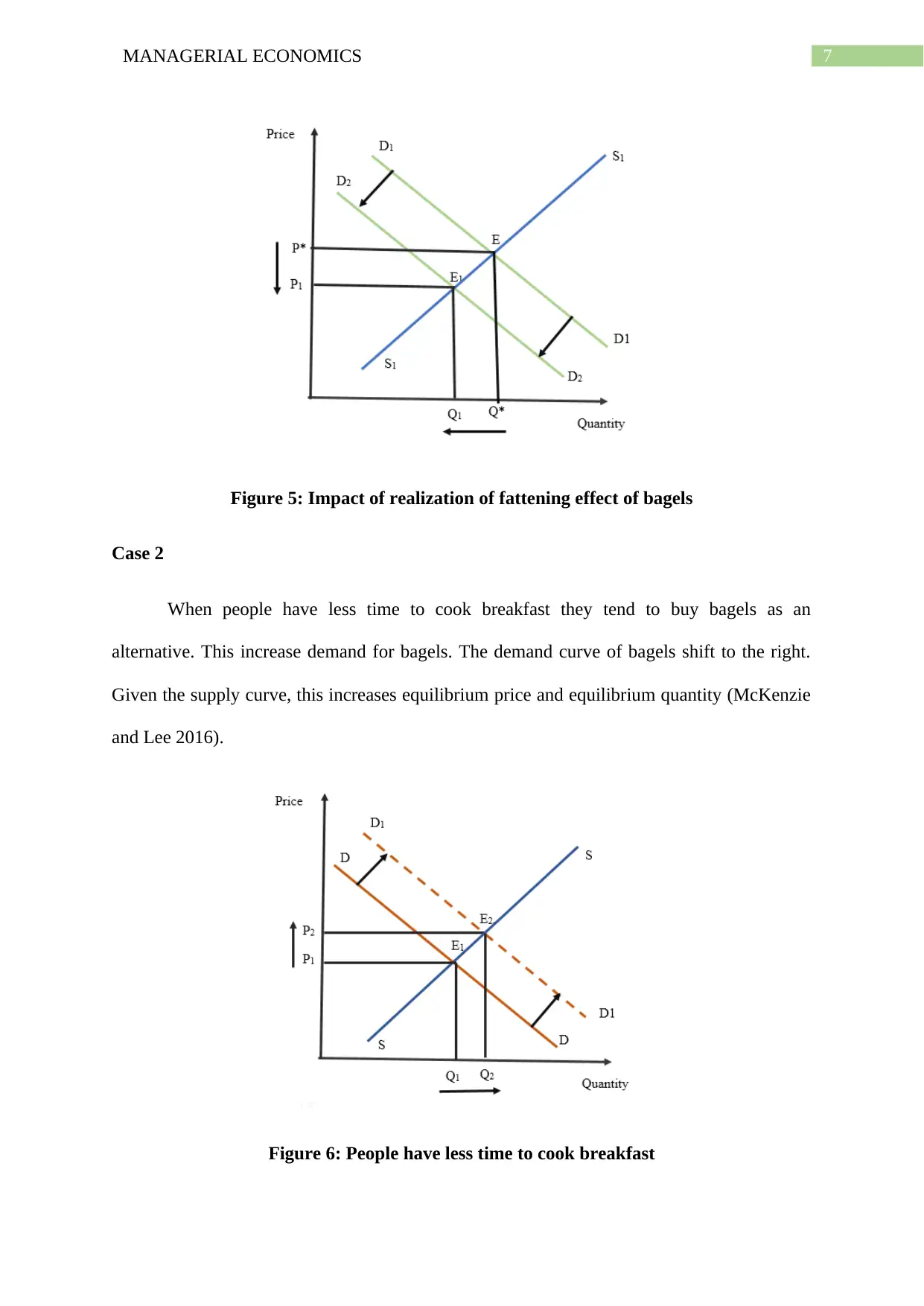
7MANAGERIAL ECONOMICS
Figure 5: Impact of realization of fattening effect of bagels
Case 2
When people have less time to cook breakfast they tend to buy bagels as an
alternative. This increase demand for bagels. The demand curve of bagels shift to the right.
Given the supply curve, this increases equilibrium price and equilibrium quantity (McKenzie
and Lee 2016).
Figure 6: People have less time to cook breakfast
Figure 5: Impact of realization of fattening effect of bagels
Case 2
When people have less time to cook breakfast they tend to buy bagels as an
alternative. This increase demand for bagels. The demand curve of bagels shift to the right.
Given the supply curve, this increases equilibrium price and equilibrium quantity (McKenzie
and Lee 2016).
Figure 6: People have less time to cook breakfast
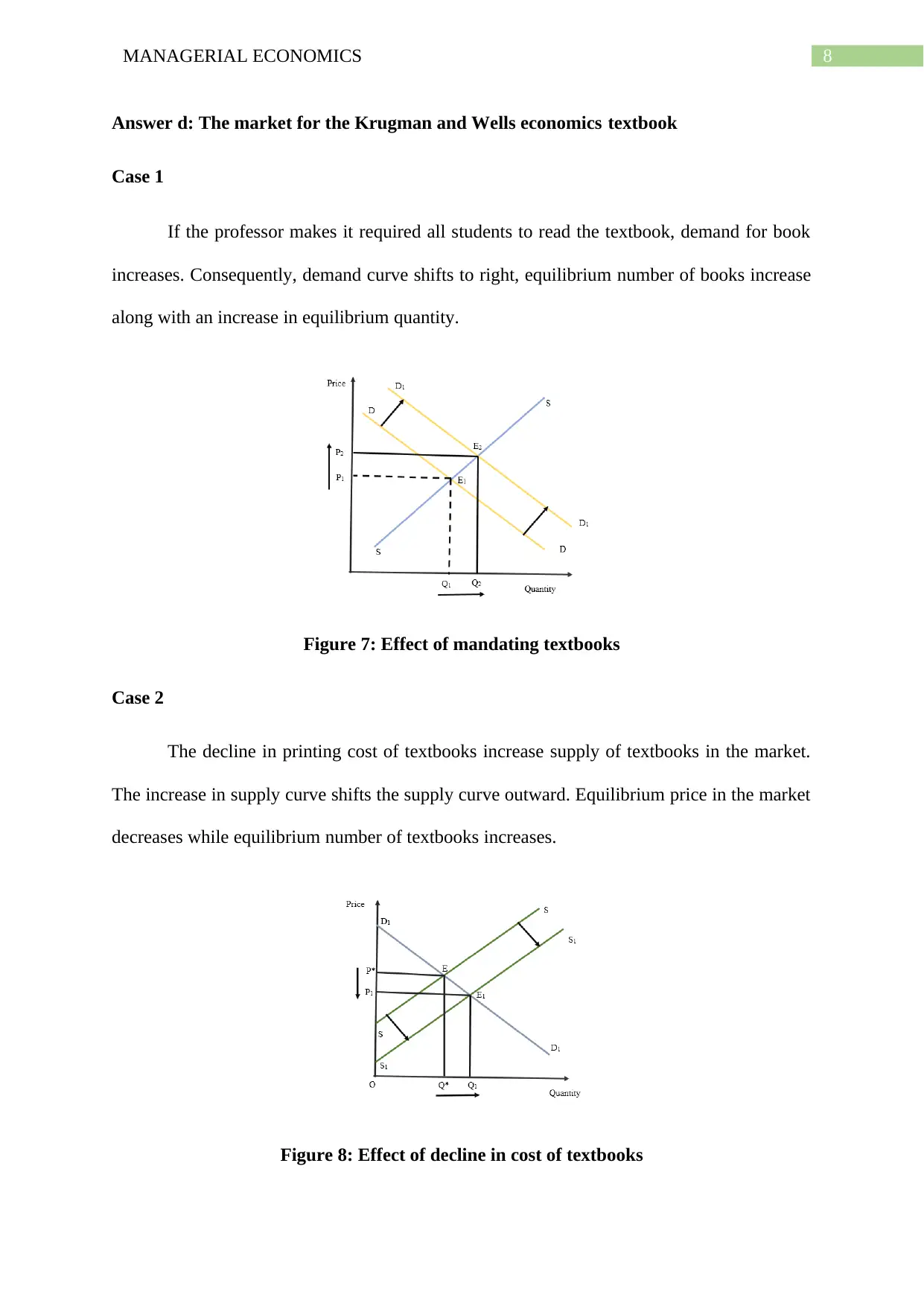
8MANAGERIAL ECONOMICS
Answer d: The market for the Krugman and Wells economics textbook
Case 1
If the professor makes it required all students to read the textbook, demand for book
increases. Consequently, demand curve shifts to right, equilibrium number of books increase
along with an increase in equilibrium quantity.
Figure 7: Effect of mandating textbooks
Case 2
The decline in printing cost of textbooks increase supply of textbooks in the market.
The increase in supply curve shifts the supply curve outward. Equilibrium price in the market
decreases while equilibrium number of textbooks increases.
Figure 8: Effect of decline in cost of textbooks
Answer d: The market for the Krugman and Wells economics textbook
Case 1
If the professor makes it required all students to read the textbook, demand for book
increases. Consequently, demand curve shifts to right, equilibrium number of books increase
along with an increase in equilibrium quantity.
Figure 7: Effect of mandating textbooks
Case 2
The decline in printing cost of textbooks increase supply of textbooks in the market.
The increase in supply curve shifts the supply curve outward. Equilibrium price in the market
decreases while equilibrium number of textbooks increases.
Figure 8: Effect of decline in cost of textbooks
⊘ This is a preview!⊘
Do you want full access?
Subscribe today to unlock all pages.

Trusted by 1+ million students worldwide
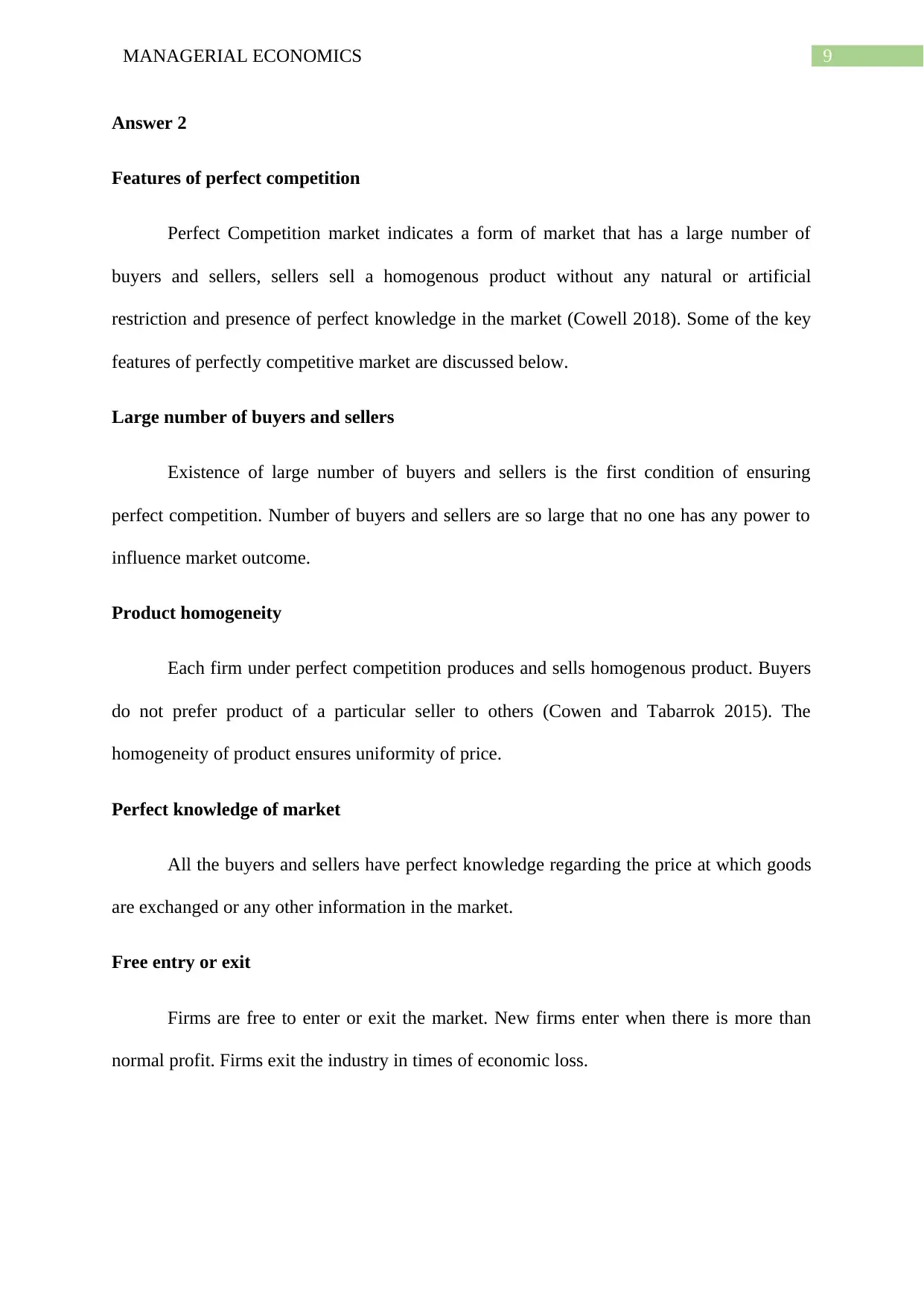
9MANAGERIAL ECONOMICS
Answer 2
Features of perfect competition
Perfect Competition market indicates a form of market that has a large number of
buyers and sellers, sellers sell a homogenous product without any natural or artificial
restriction and presence of perfect knowledge in the market (Cowell 2018). Some of the key
features of perfectly competitive market are discussed below.
Large number of buyers and sellers
Existence of large number of buyers and sellers is the first condition of ensuring
perfect competition. Number of buyers and sellers are so large that no one has any power to
influence market outcome.
Product homogeneity
Each firm under perfect competition produces and sells homogenous product. Buyers
do not prefer product of a particular seller to others (Cowen and Tabarrok 2015). The
homogeneity of product ensures uniformity of price.
Perfect knowledge of market
All the buyers and sellers have perfect knowledge regarding the price at which goods
are exchanged or any other information in the market.
Free entry or exit
Firms are free to enter or exit the market. New firms enter when there is more than
normal profit. Firms exit the industry in times of economic loss.
Answer 2
Features of perfect competition
Perfect Competition market indicates a form of market that has a large number of
buyers and sellers, sellers sell a homogenous product without any natural or artificial
restriction and presence of perfect knowledge in the market (Cowell 2018). Some of the key
features of perfectly competitive market are discussed below.
Large number of buyers and sellers
Existence of large number of buyers and sellers is the first condition of ensuring
perfect competition. Number of buyers and sellers are so large that no one has any power to
influence market outcome.
Product homogeneity
Each firm under perfect competition produces and sells homogenous product. Buyers
do not prefer product of a particular seller to others (Cowen and Tabarrok 2015). The
homogeneity of product ensures uniformity of price.
Perfect knowledge of market
All the buyers and sellers have perfect knowledge regarding the price at which goods
are exchanged or any other information in the market.
Free entry or exit
Firms are free to enter or exit the market. New firms enter when there is more than
normal profit. Firms exit the industry in times of economic loss.
Paraphrase This Document
Need a fresh take? Get an instant paraphrase of this document with our AI Paraphraser
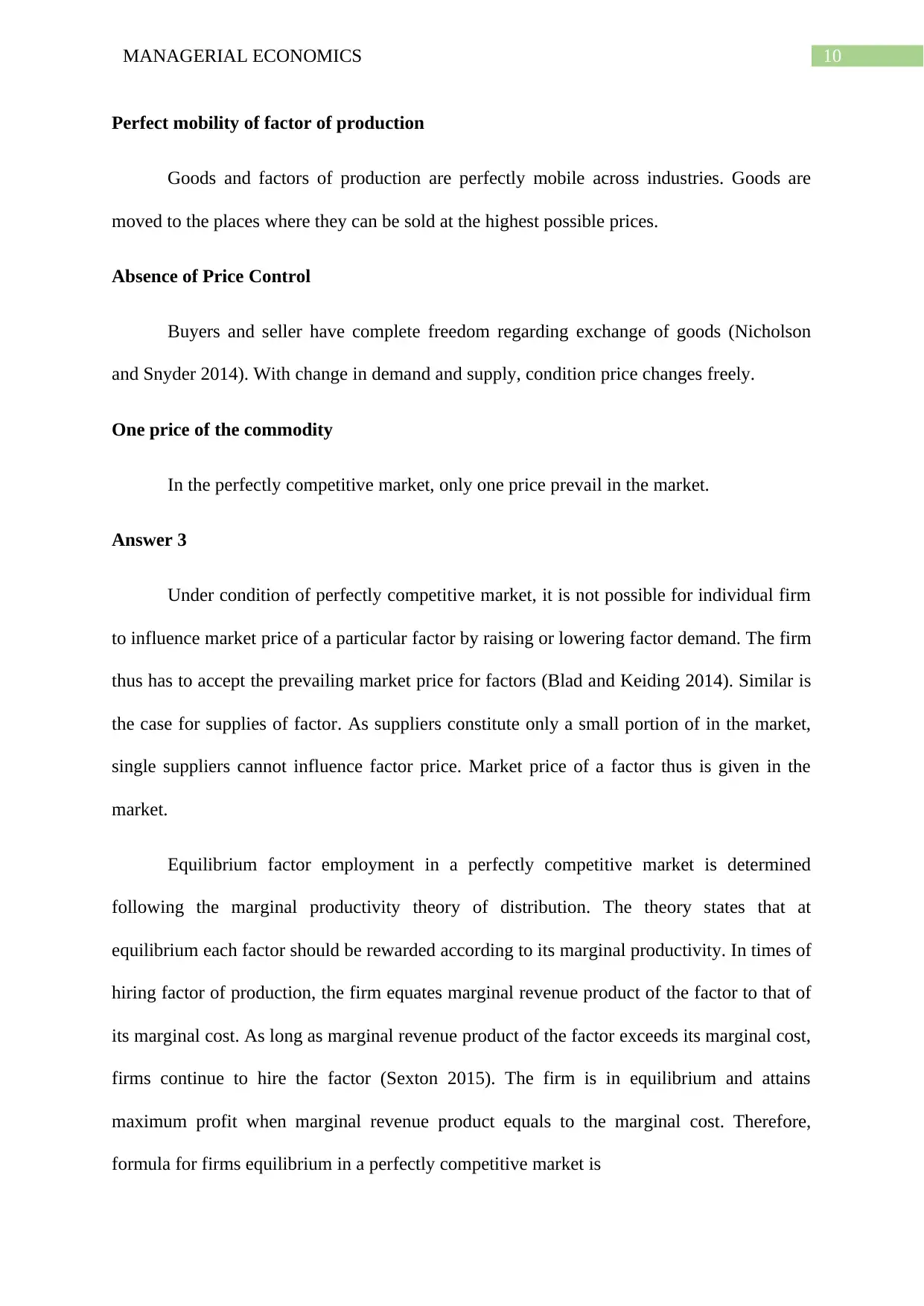
10MANAGERIAL ECONOMICS
Perfect mobility of factor of production
Goods and factors of production are perfectly mobile across industries. Goods are
moved to the places where they can be sold at the highest possible prices.
Absence of Price Control
Buyers and seller have complete freedom regarding exchange of goods (Nicholson
and Snyder 2014). With change in demand and supply, condition price changes freely.
One price of the commodity
In the perfectly competitive market, only one price prevail in the market.
Answer 3
Under condition of perfectly competitive market, it is not possible for individual firm
to influence market price of a particular factor by raising or lowering factor demand. The firm
thus has to accept the prevailing market price for factors (Blad and Keiding 2014). Similar is
the case for supplies of factor. As suppliers constitute only a small portion of in the market,
single suppliers cannot influence factor price. Market price of a factor thus is given in the
market.
Equilibrium factor employment in a perfectly competitive market is determined
following the marginal productivity theory of distribution. The theory states that at
equilibrium each factor should be rewarded according to its marginal productivity. In times of
hiring factor of production, the firm equates marginal revenue product of the factor to that of
its marginal cost. As long as marginal revenue product of the factor exceeds its marginal cost,
firms continue to hire the factor (Sexton 2015). The firm is in equilibrium and attains
maximum profit when marginal revenue product equals to the marginal cost. Therefore,
formula for firms equilibrium in a perfectly competitive market is
Perfect mobility of factor of production
Goods and factors of production are perfectly mobile across industries. Goods are
moved to the places where they can be sold at the highest possible prices.
Absence of Price Control
Buyers and seller have complete freedom regarding exchange of goods (Nicholson
and Snyder 2014). With change in demand and supply, condition price changes freely.
One price of the commodity
In the perfectly competitive market, only one price prevail in the market.
Answer 3
Under condition of perfectly competitive market, it is not possible for individual firm
to influence market price of a particular factor by raising or lowering factor demand. The firm
thus has to accept the prevailing market price for factors (Blad and Keiding 2014). Similar is
the case for supplies of factor. As suppliers constitute only a small portion of in the market,
single suppliers cannot influence factor price. Market price of a factor thus is given in the
market.
Equilibrium factor employment in a perfectly competitive market is determined
following the marginal productivity theory of distribution. The theory states that at
equilibrium each factor should be rewarded according to its marginal productivity. In times of
hiring factor of production, the firm equates marginal revenue product of the factor to that of
its marginal cost. As long as marginal revenue product of the factor exceeds its marginal cost,
firms continue to hire the factor (Sexton 2015). The firm is in equilibrium and attains
maximum profit when marginal revenue product equals to the marginal cost. Therefore,
formula for firms equilibrium in a perfectly competitive market is
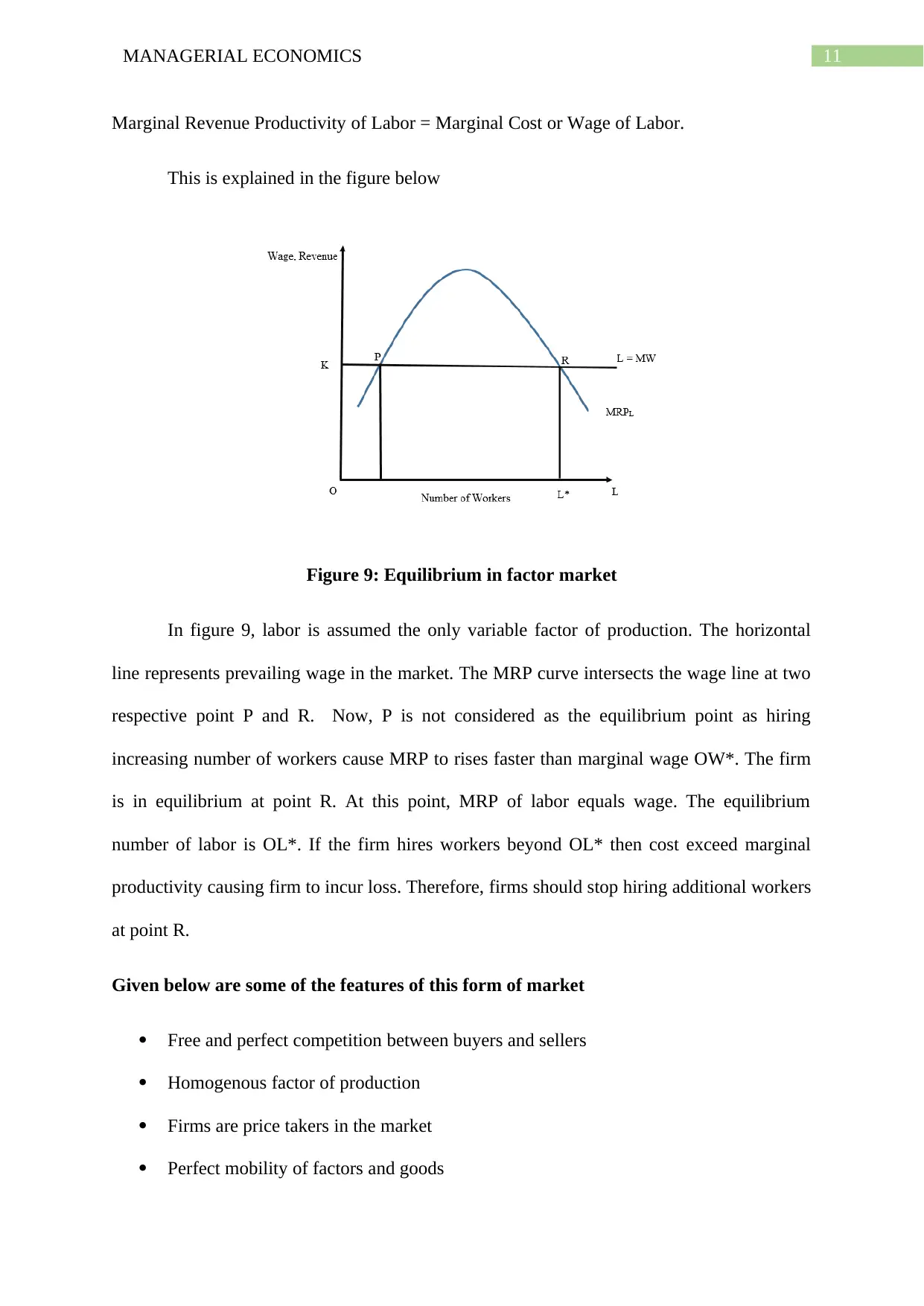
11MANAGERIAL ECONOMICS
Marginal Revenue Productivity of Labor = Marginal Cost or Wage of Labor.
This is explained in the figure below
Figure 9: Equilibrium in factor market
In figure 9, labor is assumed the only variable factor of production. The horizontal
line represents prevailing wage in the market. The MRP curve intersects the wage line at two
respective point P and R. Now, P is not considered as the equilibrium point as hiring
increasing number of workers cause MRP to rises faster than marginal wage OW*. The firm
is in equilibrium at point R. At this point, MRP of labor equals wage. The equilibrium
number of labor is OL*. If the firm hires workers beyond OL* then cost exceed marginal
productivity causing firm to incur loss. Therefore, firms should stop hiring additional workers
at point R.
Given below are some of the features of this form of market
Free and perfect competition between buyers and sellers
Homogenous factor of production
Firms are price takers in the market
Perfect mobility of factors and goods
Marginal Revenue Productivity of Labor = Marginal Cost or Wage of Labor.
This is explained in the figure below
Figure 9: Equilibrium in factor market
In figure 9, labor is assumed the only variable factor of production. The horizontal
line represents prevailing wage in the market. The MRP curve intersects the wage line at two
respective point P and R. Now, P is not considered as the equilibrium point as hiring
increasing number of workers cause MRP to rises faster than marginal wage OW*. The firm
is in equilibrium at point R. At this point, MRP of labor equals wage. The equilibrium
number of labor is OL*. If the firm hires workers beyond OL* then cost exceed marginal
productivity causing firm to incur loss. Therefore, firms should stop hiring additional workers
at point R.
Given below are some of the features of this form of market
Free and perfect competition between buyers and sellers
Homogenous factor of production
Firms are price takers in the market
Perfect mobility of factors and goods
⊘ This is a preview!⊘
Do you want full access?
Subscribe today to unlock all pages.

Trusted by 1+ million students worldwide
1 out of 27
Related Documents
Your All-in-One AI-Powered Toolkit for Academic Success.
+13062052269
info@desklib.com
Available 24*7 on WhatsApp / Email
![[object Object]](/_next/static/media/star-bottom.7253800d.svg)
Unlock your academic potential
Copyright © 2020–2025 A2Z Services. All Rights Reserved. Developed and managed by ZUCOL.





